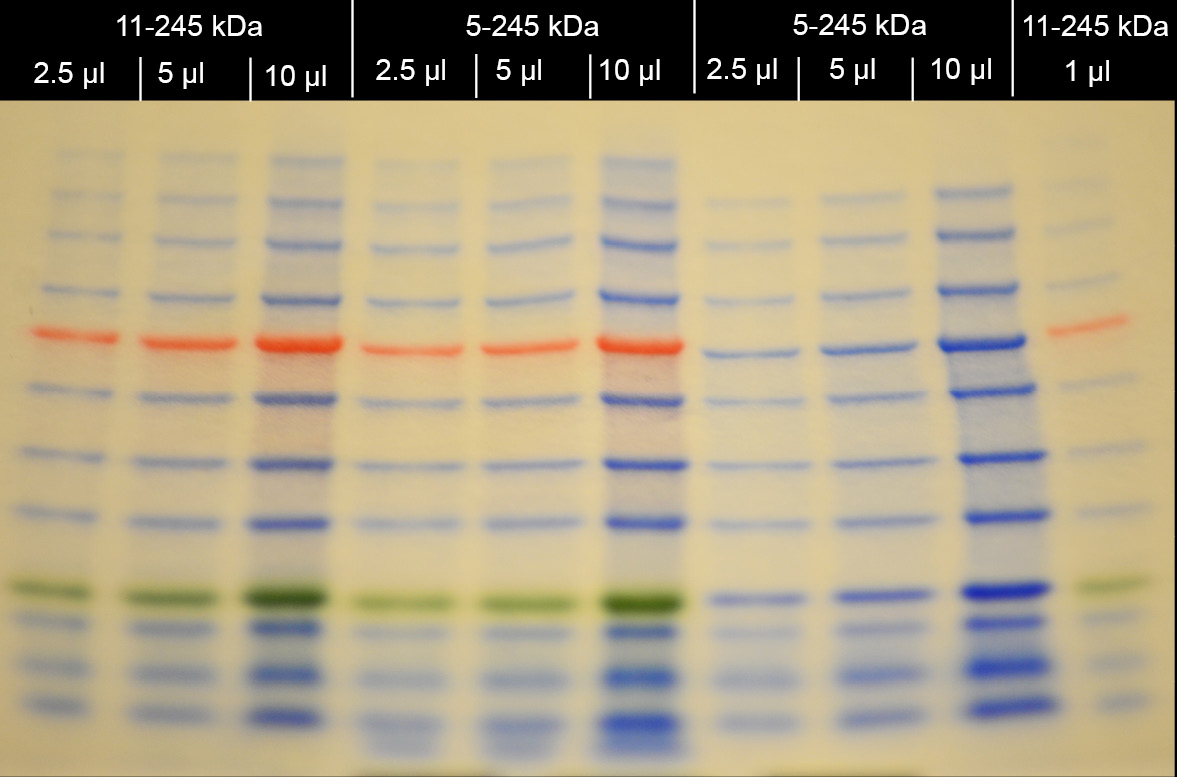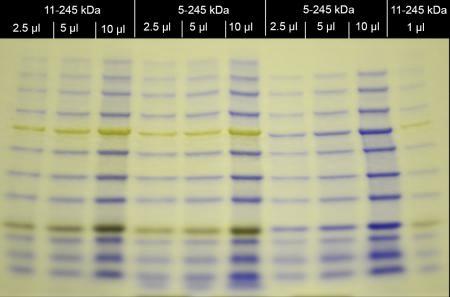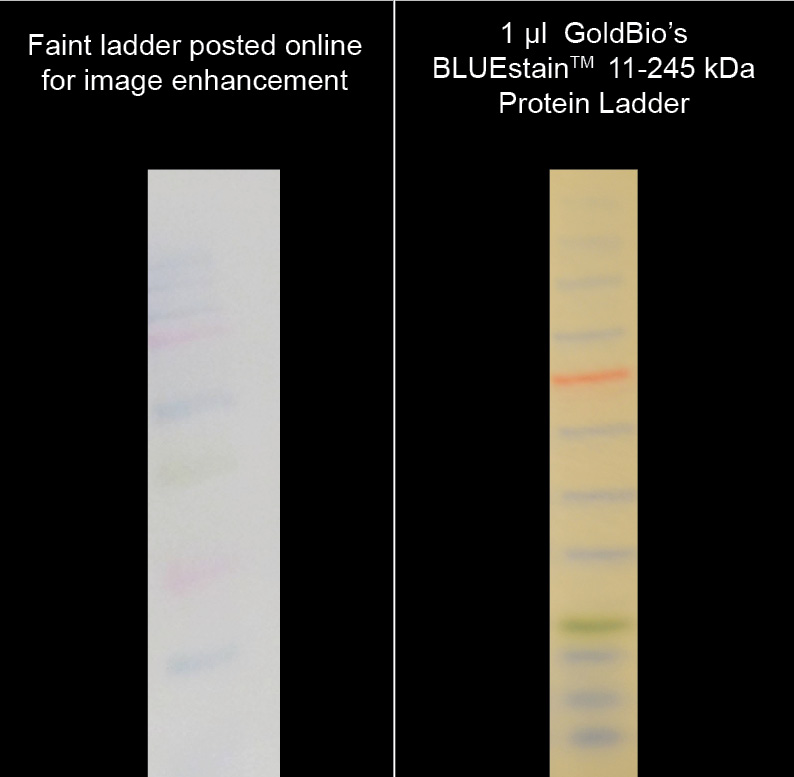Protein ladders are used as standards in the lab to identify the approximate size of a molecule. In order to work as a standard, a protein ladder is composed of varying known sizes of whole proteins which is then compared to a sample for analysis.
These ladders come stained or unstained, with some stained versions having additional colors to serve as reference points.
When most researchers look at these prestained ladders (with the reference colors) they see three distinctive colors: reds, blues and greens. But 6-8% of them might actually see fewer colors and an entirely different spectrum due to having red-green color vision deficiencies, or what most people call color blindness.
With most cases of color blindness, a person is still able to distinguish differences between most colors except various reds and greens. So, this doesn’t exactly make a prestained ladder with reference points easy for everyone in the lab to analyze, but it doesn’t make it impossible to read either so long as the bands come out crisp and clear.
Recently, we found a researcher who posted an image of his bands in a photo enhancement forum. The bands were so faint that no matter how clear your vision is, it wasn’t particularly easy to make out exactly what you had. But for him, it was even worse, and he was posting the image in hopes that someone would edit it for more saturation and vibrancy.
This got us wondering, what colors do people see in this image when they have color vision deficiencies? That actually depends on the type of color blindness and severity. To research this deeper, we polled several people with varying types of color blindness and got a wide range of answers, some including:
- “A blank white sheet of paper”
- “5 unknown dark bands”
- “7 smudges, two colors total”
- “4 bars… I see a whole lot of nothing”
- “8, maybe 9 lines. I can see two different colors”
- “Not a thing”
And using a simulator, anyone without color vision deficiencies can get a glimpse of what it might be like to see this image through other people’s eyes.
Images from Coblis – Color Blindness Simulator
 Original Image – faint reference bands can be seen: two red bands and one green band |
 Red Blind (Protanopia) Simulation – one green band is apparent, all other bands are a faint blue. |
 Green Blind (Deuteranopia) Simulation - One green band is apparent,all other bands are a faint blue. |
If these results were just a consequence of being conservative with reagent use, then this is why it’s important to either optimize your assay or see if products exist that might allow you to be a little stingy and get better results. Since our protein ladders are known for coming out crisp when only using 3-5 µl per load (competitor products require 10-15 µl per load), We became even more interested in exploring this case.
While distinguishing between the colors of a protein standard is not always essential since bands can be counted, it does help with orientation and in other areas of analysis. And even those who can see a full range of colors would look at the example above and still squint a little to see clearly.
Viewing GoldBio protein ladders using a simulator

|

|
|
On the left is GoldBio’s 11-245 kDa and 5-245 kDa protein ladders at 2.5, 5 and 10 µl. On the right are the same ladders under a color vision simulator for protanopia (red blindness). Note that the simulated image for green blindness appeared similarly. |
Comparing even 1µl of GoldBio's protein ladder to the example we found online.

|

|
|
Comparing 1 µl of GoldBio’s 11-245 kDa protein ladder to the image posted online by the original researcher requesting photo enhancement. The left shows the original images and the right shows the images placed in a color vision simulator for protanopia. Even at 1 µl, GoldBio’s bands are distinctive in both cases, and still far clearer than the faint image posted online for enhancement |
|
|
||
Of course the issue with color blindness in the lab goes beyond protein ladders. One person we polled also worked in a lab and explained that the blue, green and red images in microscopy are hard to see as well as when he used red stained cells in combination with GFP. But, researchers in these cases adapt.
In fact, this “Not The Lab” article goes into great detail about issues with color vision deficiencies when it comes to journal publications. The author builds the case by comparing examples of what cited images look like to those with full color vision, and using some simulation, what it looks like to those with color blindness. In some cases, images aren’t hard to distinguish; however, in others, it can be very difficult to interpret pictures and graphs.
While the author points out the lack of standards within publishing guidelines that would provide more accessibility to audiences with disabilities (such standards and guidelines exist in web development), we found it interesting that some laboratory equipment already has built-in recoloring features that would help researchers adapt. And journals have no rules against recoloring (false coloring) in order to optimize or highlight.
Therefore, when it comes to working in the lab and publishing, it is important to be mindful of how important sharp, distinguishable results are and to find the best products or methods to ensure those results.
|
|
||
References
Abou-Zahra, S., Arch, A., Chuter, A., Duchateau, S., Welsh, J., Loughborough, W., . . . Education and Outreach Working Group. (n.d.). Accessibility. Retrieved March 04, 2016, from https://www.w3.org/standards/webdesign/accessibili...
Blind Due to Color Blindness - Not The Lab. (2012, December 02). Retrieved March 04, 2016, from http://notthelab.blogspot.com/2012/12/blind-to-col...
What is Color Blindness. (2010). Retrieved March 04, 2016, from http://www.color-blindness.com/
 Karen Martin GoldBio Marketing Coordinator |
"To understand the universe is to understand math." My 8th grade math teacher's quote meant nothing to me at the time. Then came college, and the revelation that the adults in my past were right all along. But since math feels less tangible, I fell for biology and have found pure happiness behind my desk at GoldBio, learning, writing and loving everything science. |
Category Code: 79101 88261





